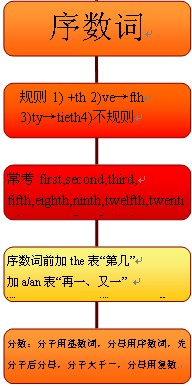本试题 “请阅读下面短文,并根据所读内容在文章后表格中的空格里填入一个最恰当的单词。注意: 请将答案写在答题卡上相应题号的横线上。 每个空格只填一个单词。The exp...” 主要考查您对序数词
等考点的理解。关于这些考点您可以点击下面的选项卡查看详细档案。
- 序数词
序数词的概念:
表示顺序的数称为序数词。如:first, second, third, fourth。
序数词的构成与用法:
1、序数词的构成:
①一般来说,是由相应的基数词加词尾th构成。
例:four+th→fourth
six+th→sixth
seven+th→seventh
ten+th→tenth
②下面这些基数词在变为序数词时,有特殊的变化。
例:one→first
two→second
three→third
five→fifth
eight→eighth
nine→ninth
twelve→twelfth
③十位整数序数词的构成方法是将基数词的词y变成i,然后再加eth。
例:twenty→twentieth
thirty→thirtieth
forty→fortieth
ninety→ninetieth
④两位或两位以上的基数词变成序数词时,仅将个位数变成序数词。
例:twenty-one→twenty-first
thirty-five→thirty-fifth
a hundred and fifty-three→a hundred and fifty-third
2、序数词的用法:
①序数词在使用时,一般加上定冠词。
例:the first book
the second floor
the third day
the fourth week.
②序数词在多数情况下都用作定语,有的也可以作表语、主语和宾语。
例:The may1st is Labour Day. 五月一日是劳动节。
My room is on the second floor. 我的房间在二楼。
The first is larger than the secon.(主语)第一个比第二个大。
Read the book from the first.(宾语)从开头读这本书。
You'll be the sixth to write.(表语)你将是第六个写的。
③序数词的前面可以加上不定冠词,用来表示“再一”,“又一”的意思。
例:You may have a third try. 你可以第三次尝试。
序数词知识体系:

约数的表达方法:
用tens/dozens/scores/hundreds/thousands/millions of 表示“几十、几百、上千、成千上万”等。
如:The boy bought dozens of pencils.
Thousands of people died in the earthquake.
注意: (A):dozen, score, hundred, thousand, million等表示确切数量时,不用复数。
如:five dozen (of) eggs 五打鸡蛋
hree hundred people 三百个人
分数词的构成和用法:
1)分数词构成法:
分数词(FractionalNumerals)由基数词和序数词构成,基数词代表分子,序数词代表分母。除了分子为1的情况下,序数词都要用复数形式:
如:1/4:one-fourth
5/9:five-ninths
2/3:two-thirds
17/5:three and two-fifths
7/12:seven-twelfths
379/8:forty-seven and three-eighths
此外还有下面表示法:
如:1/2:a(one) half
1/4:a(one) quarter
3/4:three-quarters
9/4:two and a quarter
3/2:one and half
31/4:seven and three quarters
与“请阅读下面短文,并根据所读内容在文章后表格中的空格里填入一...”考查相似的试题有:
- In the 2004 Shanghai Industrial Fair, electronic equipment,good in both quality and style,will be shown.A.a large nu...
- After 1953 _______ people have succeeded in climbing the mountain.A.several hundred ofB.several hundredsC.several ...
- 第二节短文改错(满分15分)Followed yoga (瑜伽) teacher's gentle instructions, Bai Yunuo, 76. ________15, from the Hig...
- 根据短文内容,从短文后的选项中选出能填入空白处的最佳选项。选项中有两项为多余选项The sea has always interested man. Fr...
- The Foreign Ministry Spokeswoman on Thursday urged Japan to stop making irresponsible ________ on the incident in wat...
- He found it increasingly difficult to read,________ his eyesight was beginning to fail.A.thoughB.forC.butD.so
- 此题要求改正所给短文中的错误. 对标有题号的每一行做出判断:如无错误,在该行右边横线上画一个勾(√); 如有错误(每行只有一个...
- It’s my favorite song and I will never _____ it.A.be angry withB.get tired ofC.be associated withD.get tired out
- First Job Search TipsKeep in mind that you may not get the first job you apply for, or the second... A job search can...
- The Australian boy has a good _____ of Chinese and can communicate with others freely.A.requestB.commandC.demandD...